Los bulbos de plantas se definen por el almacenamiento del ciclo de vida completo de la planta en un sistema de almacenamiento subterráneo y se dividen en dos categorías:bulbos tiernos, que no pueden sobrevivir a la congelación y deben almacenarse bajo techo durante el invierno, y bulbos resistentes, que permanecen en el suelo indefinidamente.
Los bulbos de flores son los favoritos entre los jardineros porque muchas variedades resistentes son las primeras en florecer cada primavera, trayendo color y vida a los paisajes inactivos mucho antes de que las plantas perennes comiencen a crecer de nuevo. Estos incluyen flores como tulipanes, narcisos y jacintos. Otras variedades son apreciadas por sus flores magníficas y duraderas durante el verano, como los gladiolos y las dalias.
Los bulbos son generalmente fáciles de cuidar y en su mayoría requieren poco mantenimiento, pero es importante tener en cuenta las diferentes variedades de bulbos. Después de todo, no querrías apagar tus bombillas accidentalmente dejando las equivocadas para pasar el invierno. Cómo almacenar bulbos de plantas para el invierno, los bulbos de plantación, las herramientas que necesitará para hacer el trabajo correctamente, además de las diferencias generales y los tiempos de floración de las diversas variedades se discutirán a continuación, así que siga leyendo para aprender cómo cuidar mejor su floración. tubérculos!
*También te puede interesar: Protegiendo Tus Plantas Del Frío Invernal.
COGE TUS BOMBILLAS:LO QUE NECESITAS
¡Asegúrate de elegir el lugar en el que sabes que quieres que crezcan tus bulbos y no olvides que están allí y los desentierras accidentalmente antes de que florezcan! Es posible que desee usar marcadores de plantas en las áreas en las que ha plantado para evitar que esto suceda. Los bulbos también funcionan bien en contenedores y jardineras, ¡así que no te sientas limitado por el lugar donde quieres plantar!
PARA PLANTAR
- Bombillas de su elección
- Paleta de jardín o plantador de bulbos
- Pala de jardín (para plantaciones más profundas y preparación del suelo)
- Recipientes y tierra para macetas para bulbos en maceta
- Opcional:fertilizante general
PARA ALMACENAR
- Cajas de cartón, bolsas de papel o bolsas de malla (las pantimedias viejas también sirven)
- Pala o llana de jardinería
- Área de almacenamiento fresca y seca, pero que no se congela, como un garaje o sótano
CÓMO PLANTAR TUS BULBOS
PASO 1:ELIJA LOS BULBOS CORRECTOS PARA LA TEMPORADA DE SIEMBRA CORRECTA
Ya sea que esté buscando bulbos que florezcan en primavera o un toque veraniego de colores brillantes, debe determinar si sus bulbos son de las variedades resistentes o tiernas. Como se mencionó, las variedades de bulbos resistentes necesitan pasar el invierno en temperaturas bajo cero, y se plantan mejor en el otoño para que emerjan en la primavera.
Los bulbos tiernos no pueden tolerar las temperaturas bajo cero y deben almacenarse cada otoño en un lugar fresco y seco para volver a plantarlos en la primavera para las flores de verano después de la última helada y el suelo se haya descongelado. El saco en el que vienen tus bulbos debe estar etiquetado con el tipo de variedad. 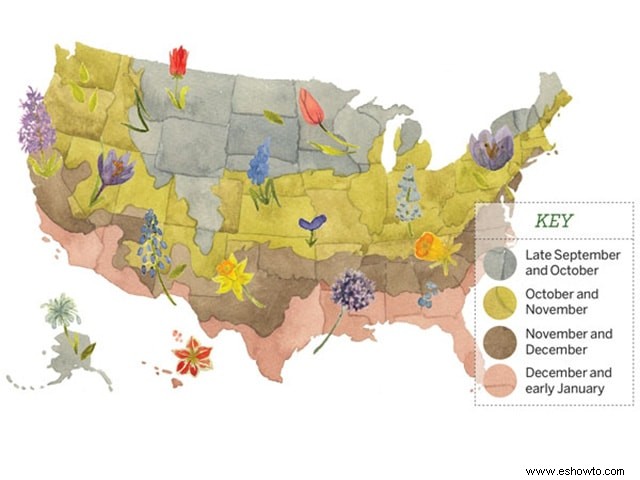
Fuente
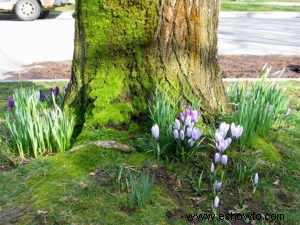
PASO 2:LOCALIZA UN ÁREA PARA PLANTAR
La belleza de los bulbos es que una vez que han florecido y gastado su belleza, vuelven a la inactividad y permiten que las plantas perennes posteriores crezcan a su alrededor durante los cambios de estación. Esto significa que puede plantar sus bulbos prácticamente en cualquier lugar donde desee un toque de color, y uno de mis sitios favoritos son los pequeños lechos de azafranes que crecen temprano a través de la nieve de primavera alrededor de árboles y arbustos que generalmente están rodeados por un césped verde cuando llega el verano. .
A los bulbos les gustan los lugares soleados, pero dado que la mayoría de las áreas sombreadas todavía están llenas de sol cuando llega la primavera, no se preocupe demasiado por la ubicación, siempre que reciban la luz del día antes de que florezcan.
Solo recuerda tener en cuenta que los bulbos resistentes (la mayoría de las variedades) permanecerán en el suelo durante todo el año, y si decides hacer algún cambio en el jardín, deberás trasplantarlos para evitar destruirlos accidentalmente.
Fuente
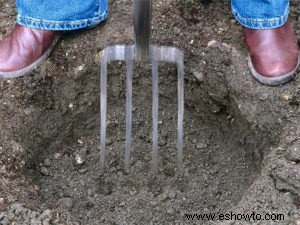
PASO 3:PREPARAR EL SUELO
Como la mayoría de las raíces de las plantas, los bulbos no son grandes fanáticos de sentarse en el agua y morirán por falta de oxígeno. Muchos pueden tolerar períodos secos, especialmente durante la latencia, así que tenga esto en cuenta cuando elija su lugar y comience a preparar el suelo. Obviamente, si el área que elige está bajo el agua una buena parte del año, es posible que desee reconsiderar su elección.
Los bulbos pueden manejar la mayoría de los tipos de suelos, y para asegurar un buen comienzo, afloje los suelos en los que planea plantar y agregue un poco de compost o turba para mantener los suelos húmedos y ricos en nutrientes durante el crecimiento inicial, pero de lo contrario puede más o menos plántalos y aléjate.
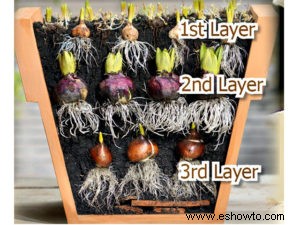
PASO 4:DETERMINE SU DISEÑO
Dependiendo de sus opciones de bombillas, puede colocar diferentes tipos en capas para proporcionar una floración continua en un lugar durante cada temporada. Coloque los bulbos de floración temprana, como los azafranes, sobre los que florecen más tarde, como los tulipanes. Los bulbos más grandes que florecen más tarde deben plantarse más profundo de todos modos, y a medida que se agota la floración de cada planta, ¡otra ocupará su lugar! Siéntase libre de crear varias capas para lograr el aspecto que desea.
Si las capas no son su elección, asegúrese de plantar suficientes bulbos para que el espacio obtenga el color que desea. Por lo general, desea tener en cuenta el tamaño de la bombilla y la cantidad de espacio que tiene. Considere enchapar cada uno dentro de aproximadamente 4 a 6 pulgadas uno del otro. Smaller varieties, such as crocuses or hyacinth you may want even closer.
Source
STEP 5:DIG HOLES
As mentioned above, different varieties do require different depths. Early bloomers are typically smaller, and require a shallower bed, whereas later bloomers have a larger base, and can tolerate a deeper depth. Special bulb planters are available to easily create the hole you need to drop each bulb in.
Take note of what types of bulbs you have, and either follow the directions on the bag, or research to make sure you are providing the best start possible. Also be sure to note your depths for tender varieties so you can make sure you get them all each fall when you dig them up for the winter.
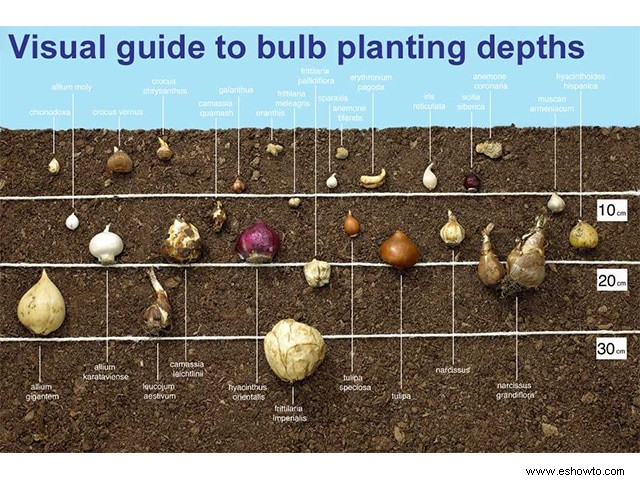
Source
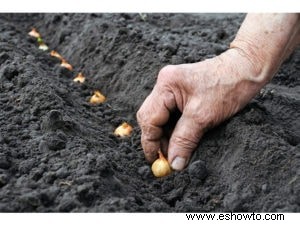
STEP 6:PLANT BULBS
Be sure to plant bulbs right side up so new shoots point towards the direction you want them to go. Some bulbs will right themselves, but for the most part they may stay in dormancy if unable to reach topsoil, and possibly die if they are unable to get the nutrients they need from the sunlight. Generally pointed tops indicate where leaves and buds will break from, and rounded bottoms are where roots will take hold.
Bulbs are extremely hardy for the most part however, and can stay in dormancy for two years or more in the correct conditions- and even I have had some that were accidentally dug up and reburied wrong, only to make an entrance after a few years when I thought they were dead.
Source
STEP 7:COVER, FERTILIZE, AND MULCH
Once you’ve tucked away your bulbs for the winter (or summer) under a layer of soil, feel free to add a general fertilizer to the soil to give them an extra boost once they take hold. Mulching your topsoil is always a good option as well as it will help hold in heat once the area begins to receive sun, as well as dissuade weeds from taking root.

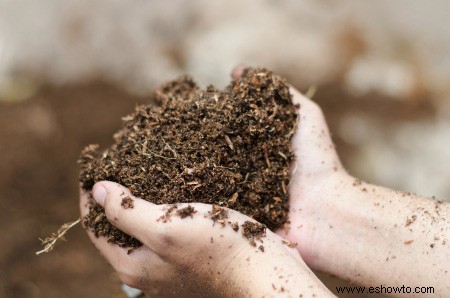
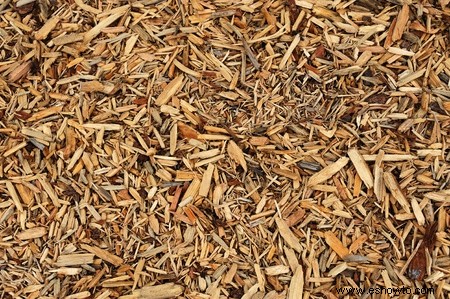
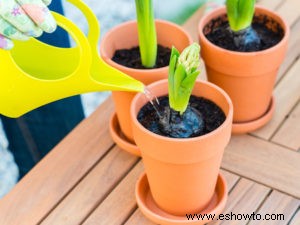
STEP 8:WATER
Like any newly planted vegetation, these little guys need water to get started. Be sure to water your soils thoroughly at first, and keep in it your regular garden watering rotation afterwards until the first freeze. Well watered areas are generally the first to bloom and have the largest flowers in my experience.
STEP 9:DIVIDE AFTER A FEW YEARS AND REPLANT
Since bulbs are self-propagating, after the foliage has died down, simply dig up the clumps (being careful not to damage the actual bulb). Then, divide the bulb clumps and replant to cover a larger area! Remember, smaller bulbs make take a few years to truly set, so be patient!
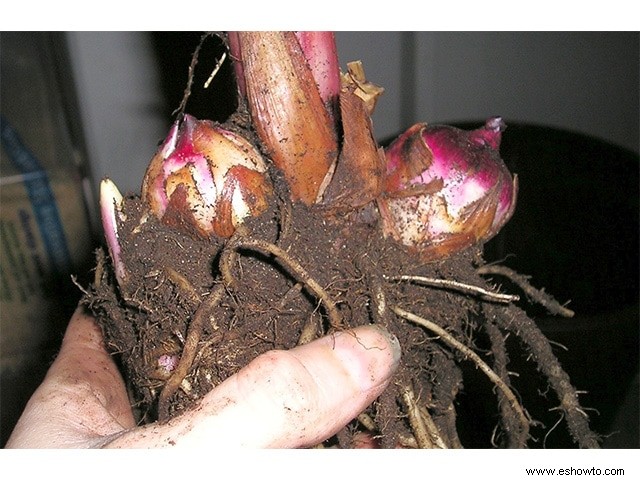
Source
HOW TO STORE PLANT BULBS FOR NEXT SEASON
Your tender varieties need to be stored each spring before the ground freezes, and ideally the time to dig is once they have gone dormant for the season after the first frost. Each plant has a different way of showing dormancy, so it is important that you learn the needs of your bulbs if you will be digging them each fall.
STEP 1:GET A GOOD CONTAINER TO STORE YOUR BULBS IN
To start, you need to make sure you have something to put your bulbs in once you have them removed from the soil. Paper bags, cardboard boxes, or breathable mesh are all good candidates for your plants’ winter home over the few months they will be out of the soil.
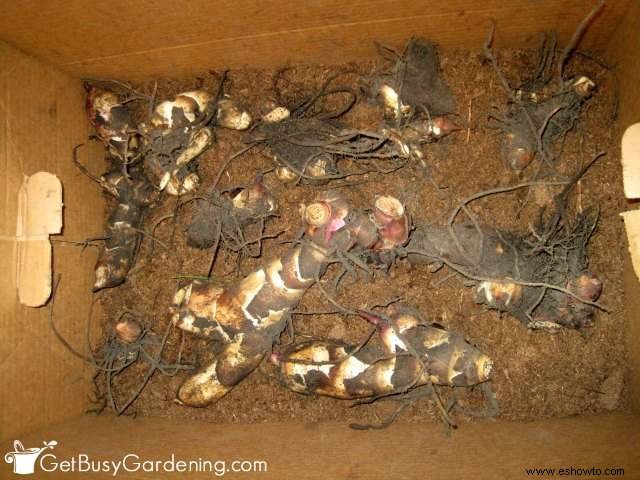
Source
STEP 2:CUT BACK YEAR’S GROWTH
With a pair of pruning shears, cut off spent stems and leaves down to about 3 inches from the top of the soil. If you choose, you can cut after you dig if old leaves make it easier to locate what’s beneath the soil. Be careful not to cut into the root bulb itself as mentioned earlier, and if you do treat it immediately with a fungicide.
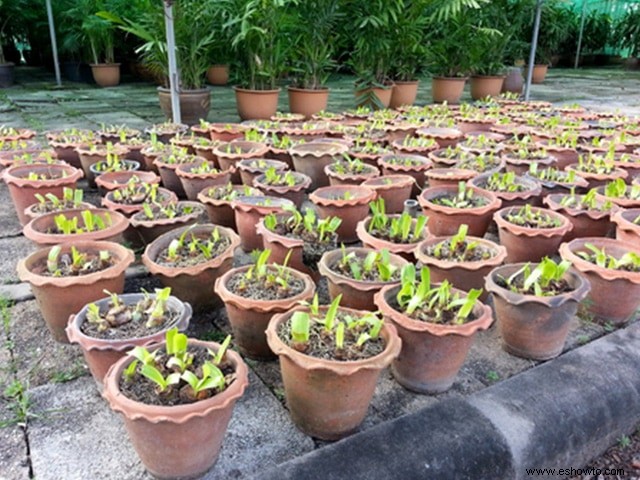
STEP 3:DIG UP YOUR BULBS
Be sure to take care completing this step. You want to make sure you do not pierce any of the bulbs as you could introduce bacteria and rot, or even kill the individual bulb. If you do manage to have an accident, wipe the area with a fungicide to discourage any sort of yucky growth that could compromise your plants.
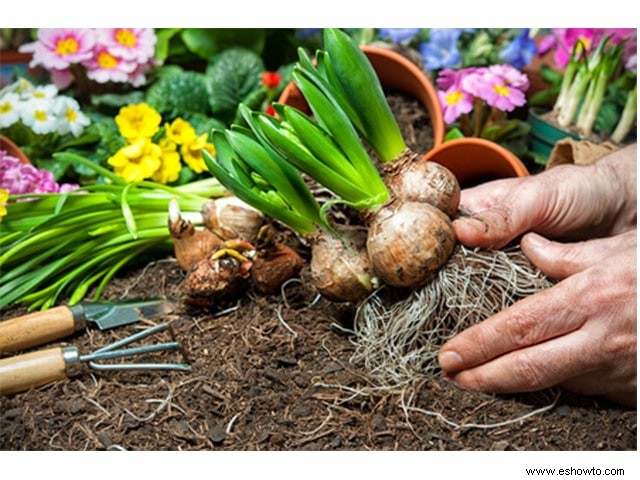
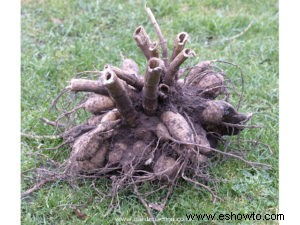
STEP 4:CLEAN, DRY, OR PREPARE YOUR VARIETY AS NEEDED
Gently brush off as much excess dirt as you can using a clean dry garden glove or towel. You do not want to use any water as this will introduce too much moisture to the bulb and can cause rot. You also will want to take care that your bulbs are dried out if you have dug them from moist soil to ensure proper storage.
If your bulbs are wet when you dig them, simply lay them out separately on a piece of mesh or cardboard and allow them to air dry. Brush off any dirt that might have been stuck to them when wet at this point.
Source
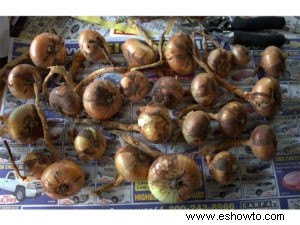
STEP 5:STORE BULBS
¡Felicidades! You are now ready to store your bulbs! If they are dried and cleaned off, place them into your storage container and put into a cool, dry place until the soil has thawed and any freezes have passed for the winter.
Feel free to layer your bulbs in boxes by placing a layer of newspaper between each layer, or packing into shredded paper. Remember, your bulbs need to breathe, so make sure you have ample air circulation. Also, make sure you label your bulbs so you can get them back where they belong in the spring!
Source
FOR SPRING BLOOMING BULBS THAT MISSED THE FALL PLANTING:
Consider placing these bulbs directly in the refrigerator as they need 6-8 weeks of cold in order to bloom. Once the ground is malleable, you can plant them directly into their spots for seasonal blooms. Don’t worry if some don’t come up the first year, chances are they just need another season and will come up later.
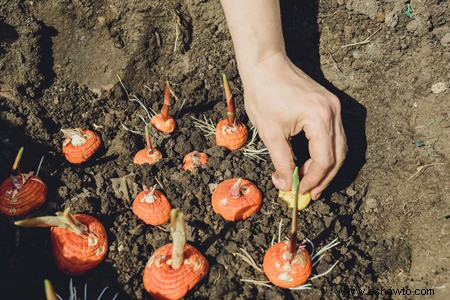
WHAT ARE YOU WAITING FOR?!
I don’t know about you, but I am already thinking about where I want to add bulbs this fall for more spring color. I have a fairly young garden too, and have yet to add any tender bulbs to my plantings, but I think after all this research, the time has come!
Remember, bulbs are EASY to plant and take care of, so follow the few simple rules set out above and watch your garden come alive!

- Plant at the correct time of the season
- Prepare soils and plant at the correct depth
- Keep well watered, but not saturated
- Dig tender varieties after first frost
- Use correct, breathable storage methods
Questions, comments, tips you want to share? Please leave your messages below, and as always, please share!

